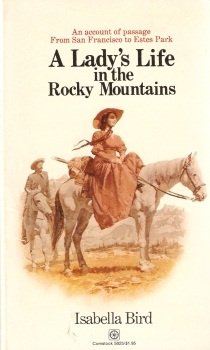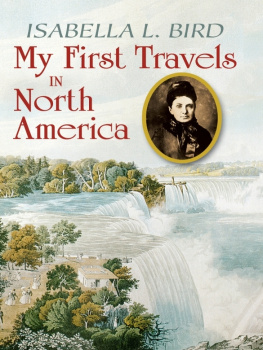Letter I
Lake TahoeMorning in San FranciscoDustA Pacific mail-trainDigger IndiansCape HornA mountain hotelA pioneerA Truckee livery stableA mountain streamFinding a bearTahoe.
LAKE TAHOE, September 2.
I have found a dream of beauty at which one might look all one's life and sigh. Not lovable, like the Sandwich Islands, but beautiful in its own way! A strictly North American beautysnow-splotched mountains, huge pines, red-woods, sugar pines, silver spruce; a crystalline atmosphere, waves of the richest color; and a pine-hung lake which mirrors all beauty on its surface. Lake Tahoe is before me, a sheet of water twenty-two miles long by ten broad, and in some places 1,700 feet deep. It lies at a height of 6,000 feet, and the snow-crowned summits which wall it in are from 8,000 to 11,000 feet in altitude. The air is keen and elastic. There is no sound but the distant and slightly musical ring of the lumberer's axe.
It is a weariness to go back, even in thought, to the clang of San Francisco, which I left in its cold morning fog early yesterday, driving to the Oakland ferry through streets with side-walks heaped with thousands of cantaloupe and water-melons, tomatoes, cucumbers, squashes, pears, grapes, peaches, apricotsall of startling size as compared with any I ever saw before. Other streets were piled with sacks of flour, left out all night, owing to the security from rain at this season. I pass hastily over the early part of the journey, the crossing the bay in a fog as chill as November, the number of "lunch baskets," which gave the car the look of conveying a great picnic party, the last view of the Pacific, on which I had looked for nearly a year, the fierce sunshine and brilliant sky inland, the look of long RAINLESSNESS, which one may not call drought, the valleys with sides crimson with the poison oak, the dusty vineyards, with great purple clusters thick among the leaves, and between the vines great dusty melons lying on the dusty earth. From off the boundless harvest fields the grain was carried in June, and it is now stacked in sacks along the track, awaiting freightage. California is a "land flowing with milk and honey." The barns are bursting with fullness. In the dusty orchards the apple and pear branches are supported, that they may not break down under the weight of fruit; melons, tomatoes, and squashes of gigantic size lie almost unheeded on the ground; fat cattle, gorged almost to repletion, shade themselves under the oaks; superb "red" horses shine, not with grooming, but with condition; and thriving farms everywhere show on what a solid basis the prosperity of the "Golden State" is founded. Very uninviting, however rich, was the blazing Sacramento Valley, and very repulsive the city of Sacramento, which, at a distance of 125 miles from the Pacific, has an elevation of only thirty feet. The mercury stood at 103 degrees in the shade, and the fine white dust was stifling.
In the late afternoon we began the ascent of the Sierras, whose sawlike points had been in sight for many miles. The dusty fertility was all left behind, the country became rocky and gravelly, and deeply scored by streams bearing the muddy wash of the mountain gold mines down to the muddier Sacramento. There were long broken ridges and deep ravines, the ridges becoming longer, the ravines deeper, the pines thicker and larger, as we ascended into a cool atmosphere of exquisite purity, and before 6 P.m. the last traces of cultivation and the last hardwood trees were left behind.
I. L. B.
(Author's note to the third edition, January 16, 1880.)
At Colfax, a station at a height of 2,400 feet, I got out and walked the length of the train. First came two great gaudy engines, the Grizzly Bear and the White Fox, with their respective tenders loaded with logs of wood, the engines with great, solitary, reflecting lamps in front above the cow guards, a quantity of polished brass-work, comfortable glass houses, and well-stuffed seats for the engine-drivers. The engines and tenders were succeeded by a baggage car, the latter loaded with bullion and valuable parcels, and in charge of two "express agents." Each of these cars is forty-five feet long. Then came two cars loaded with peaches and grapes; then two "silver palace" cars, each sixty feet long; then a smoking car, at that time occupied mainly by Chinamen; and then five ordinary passenger cars, with platforms like all the others, making altogether a train about 700 feet in length.
The platforms of the four front cars were clustered over with Digger Indians, with their squaws, children, and gear. They are perfect savages, without any aptitude for even aboriginal civilization, and are altogether the most degraded of the ill-fated tribes which are dying out before the white races. They were all very diminutive, five feet one inch being, I should think, about the average height, with flat noses, wide mouths, and black hair, cut straight above the eyes and hanging lank and long at the back and sides. The squaws wore their hair thickly plastered with pitch, and a broad band of the same across their noses and cheeks. They carried their infants on their backs, strapped to boards. The clothing of both sexes was a ragged, dirty combination of coarse woolen cloth and hide, the moccasins being unornamented. They were all hideous and filthy, and swarming with vermin. The men carried short bows and arrows, one of them, who appeared to be the chief, having a lynx's skin for a quiver. A few had fishing tackle, but the bystanders said that they lived almost entirely upon grasshoppers. They were a most impressive incongruity in the midst of the tokens of an omnipotent civilization.
The light of the sinking sun from that time glorified the Sierras, and as the dew fell, aromatic odors made the still air sweet. On a single track, sometimes carried on a narrow ledge excavated from the mountain side by men lowered from the top in baskets, overhanging ravines from 2,000 to 3,000 feet deep, the monster train SNAKED its way upwards, stopping sometimes in front of a few frame houses, at others where nothing was to be seen but a log cabin with a few Chinamen hanging about it, but where trails on the sides of the ravines pointed to a gold country above and below. So sharp and frequent are the curves on some parts of the ascent, that on looking out of the window one could seldom see more than a part of the train at once. At Cape Horn, where the track curves round the ledge of a precipice 2,500 feet in depth, it is correct to be frightened, and a fashion of holding the breath and shutting the eyes prevails, but my fears were reserved for the crossing of a trestle bridge over a very deep chasm, which is itself approached by a sharp curve. This bridge appeared to be overlapped by the cars so as to produce the effect of looking down directly into a wild gulch, with a torrent raging along it at an immense depth below.
Shivering in the keen, frosty air near the summit pass of the Sierras, we entered the "snow-sheds," wooden galleries, which for about fifty miles shut out all the splendid views of the region, as given in dioramas, not even allowing a glimpse of "the Gem of the Sierras," the lovely Donner Lake. One of these sheds is twenty-seven miles long. In a few hours the mercury had fallen from 103 degrees to 29 degrees, and we had ascended 6,987 feet in 105 miles! After passing through the sheds, we had several grand views of a pine forest on fire before reaching Truckee at 11 P.m. having traveled 258 miles. Truckee, the center of the "lumbering region" of the Sierras, is usually spoken of as "a rough mountain town," and Mr. W. had told me that all the roughs of the district congregated there, that there were nightly pistol affrays in bar-rooms, etc., but as he admitted that a lady was sure of respect, and Mr. G. strongly advised me to stay and see the lakes, I got out, much dazed, and very stupid with sleep, envying the people in the sleeping car, who were already unconscious on their luxurious couches. The cars drew up in a streetif street that could be called which was only a wide, cleared space, intersected by rails, with here and there a stump, and great piles of sawn logs bulking big in the moonlight, and a number of irregular clap-board, steep-roofed houses, many of them with open fronts, glaring with light and crowded with men. We had pulled up at the door of a rough Western hotel, with a partially open front, being a bar-room crowded with men drinking and smoking, and the space between it and the cars was a moving mass of loafers and passengers. On the tracks, engines, tolling heavy bells, were mightily moving, the glare from their cyclopean eyes dulling the light of a forest which was burning fitfully on a mountain side; and on open spaces great fires of pine logs were burning cheerily, with groups of men round them. A band was playing noisily, and the unholy sound of tom-toms was not far off. Mountainsthe Sierras of many a fireside dreamseemed to wall in the town, and great pines stood out, sharp and clear cut, against a sky in which a moon and stars were shining frostily.







